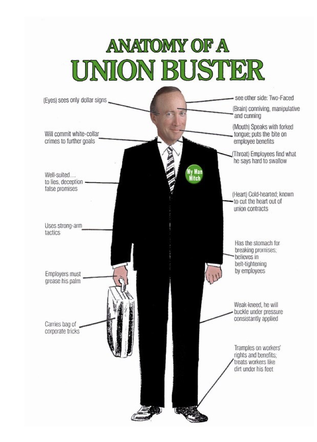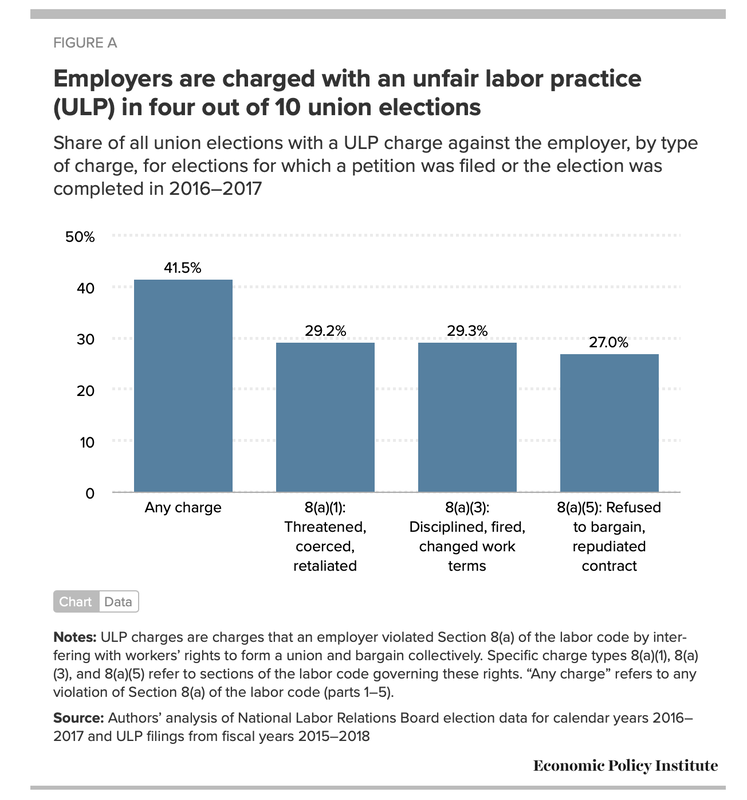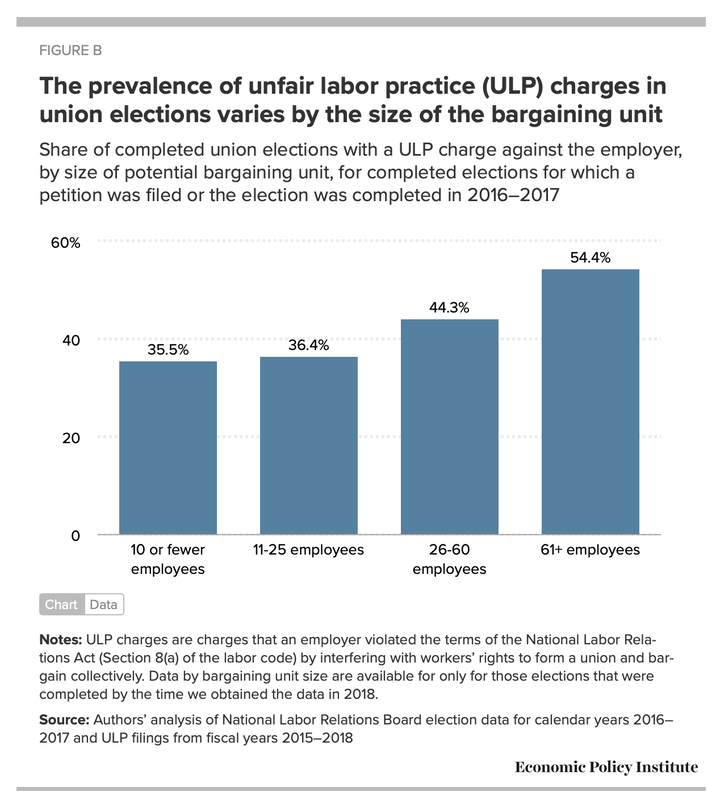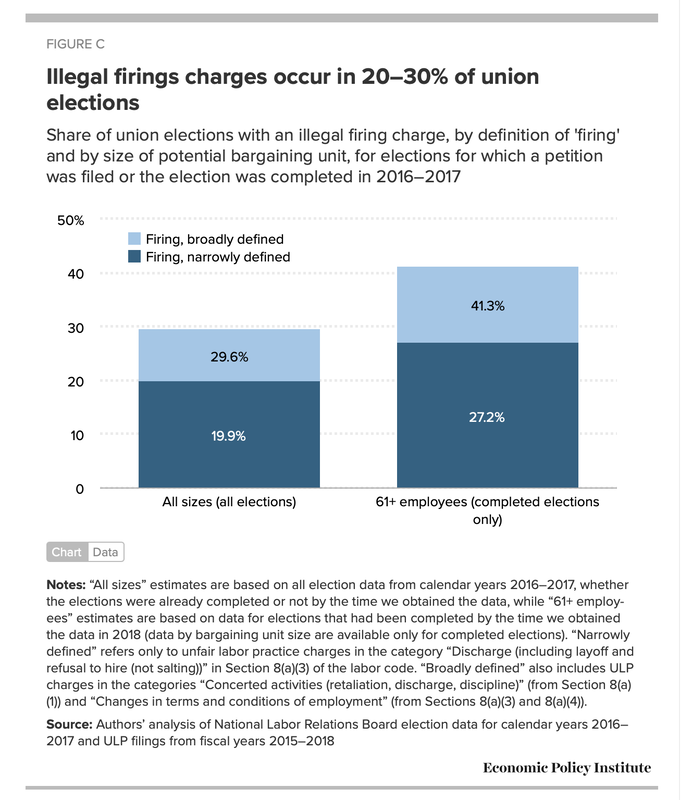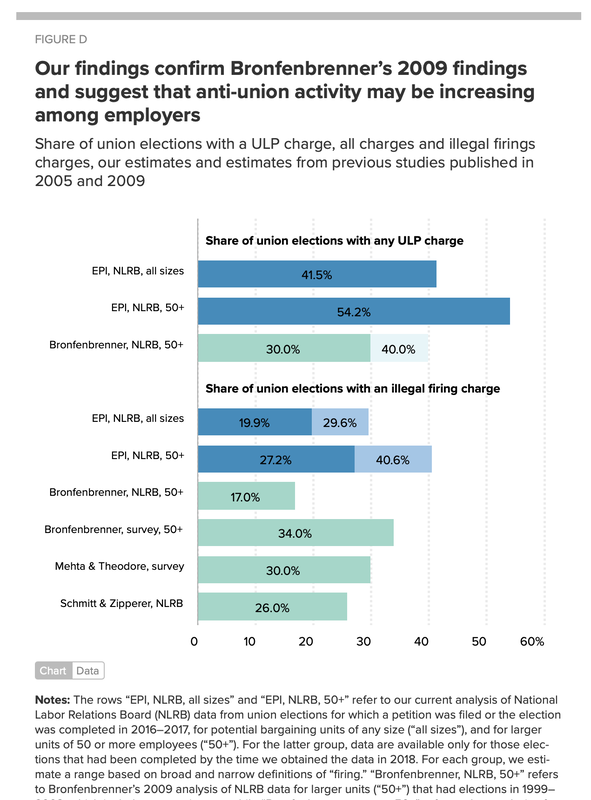Union-busting is a practice undertaken by an employer or their agents to prevent employees from joining a labor union, or to disempower, subvert, or destroy unions that already exist. Union busting is a field populated by bullies and built on deceit. The only way to bust a union is to lie, distort, manipulate, threaten, and always, always attack.
-Martin Jay Levitt, 1993, Confessions of a Union Buster
Tactics
Mohawk Valley Formula
source: https://en.wikipedia.org/wiki/Mohawk_Valley_formula
The Mohawk Valley formula includes: discrediting union leaders and labelling them ‘agitators,’ scaring the public with threats of violence, intimidating strikers using the police force and vigilantes, forming puppet groups of ‘loyal workers’ to influence public debate and discredit strikers, protecting and fortifying workplaces, often with private security forces, employing large numbers of strikebreakers to work in place of strikers, and threatening closure of the workplace if the workers do not return to work.
Strategies:
source: https://en.wikipedia.org/wiki/Mohawk_Valley_formula
The Mohawk Valley formula includes: discrediting union leaders and labelling them ‘agitators,’ scaring the public with threats of violence, intimidating strikers using the police force and vigilantes, forming puppet groups of ‘loyal workers’ to influence public debate and discredit strikers, protecting and fortifying workplaces, often with private security forces, employing large numbers of strikebreakers to work in place of strikers, and threatening closure of the workplace if the workers do not return to work.
Strategies:
- When a strike is threatened, label the union leaders as "agitators" to discredit them with the public and their own followers.
- Raise high the banner of "law and order"
- Call a "mass meeting" to coordinate public sentiment against the strike
- Form a large police force to intimidate the strikers and exert a psychological effect. Utilize local police, state police, vigilantes and special deputies
- Convince the strikers their cause is hopeless with a "back-to-work" movement by a puppet association of so-called "loyal employees" secretly organized by the employer.
- When enough applications are on hand, set a date for opening the plant by having such opening requested by the puppet "back-to-work" association.
- Stage the "opening" theatrically by throwing open the gates and having the employees march in a mass protected by squads of armed police so as to dramatize and exaggerate the opening and heighten the demoralizing effect.
- Demoralize the strikers with a continuing show of force. If necessary turn the locality into a warlike camp and barricade it from the outside world.
- Close the publicity barrage on the theme that the plant is in full operation and the strikers are merely a minority attempting to interfere with the right to work. With this, the campaign is over—the employer has broken the strike.
Intimidation & Alienation
source: https://www.jwj.org/unionbusters-101
source: https://colectivounionyes.com/?page_id=54
:
Distraction
source: https://boilermakers.org/organizing/union-busting
Fear
source: https://www.leosudc.org/union-busting-tactics
During this campaign, beware of the fact that management and their consultants will try everything in their power to deceive you in their attempts to keep control. No employer wants to give up control to its employees.
They'll use letters, rumors, threats, phony committees, captive audience meetings, special perks, videos, fear, scare tactics, lies about corruption and anything else they can think of.
These methods are contained in standard propaganda packages developed and sold by highly paid professional "union-busting" consultants.
source: https://www.jwj.org/unionbusters-101
- Divide and Conquer: Unionbusters manipulate staff dynamics to make employees feel that there is a tense division among staff concerning unions. They may go so far as to pit one group of employees against each other, based on race, ethnicity, gender, or class
- One-on-One Meetings: During union organizing drives, 77 percent of workers are forced to attend intimidating, closed-door or isolated meetings with supervisors. These aren’t friendly impromptu chats, but well-planned meetings designed by unionbusters to decipher employees’ feelings about the union and persuade them against the union.
- Captive Audience Meetings: So-called “captive audience” meetings are held for employees during work hours to disseminate propaganda against union representation and to attempt to discredit the union. Eighty-nine percent of employers hold captive audience meetings during an organizing drive. Employees are almost always required to attend, but union organizers may be intentionally disinvited. Often, the meetings are rigged so that workers who are already against the union are assigned to ask questions to sow misinformation.
source: https://colectivounionyes.com/?page_id=54
:
- Shadowing: A union buster will target employees who they know they can sway against the union. The union buster will then have supervisor’s shadowing or constantly overseeing that employee to cause fear in that employee about his or her job.
Distraction
source: https://boilermakers.org/organizing/union-busting
- They want you to give them a second chance to make things right. “Wait and see” — this plays to their tactic to convince workers that they’re listening and can take care of your concerns without the need for a third-party union. They may promise to do better, to change their behavior, or even reassign difficult supervisors. The truth is that while they may make some changes initially that are good for workers, after the union organizing stops, they go back to their old ways.
- They will say “We’re worried about what might happen to you.” They aren’t really worried about you. They’re worried about themselves.
- They may start paying more attention to you. Either in an effort to win you over as a worker who can side with them against pro-union workers or to play on your desire to be seen as a good worker. Don’t fall for it. It won’t last.
- They will claim they had no idea workers were unhappy. Management often claims they didn't know workers were dissatisfied with working conditions, unfair treatment, repressive policies, lack of pay raises, or lousy benefits. If management truly didn't know about worker dissatisfaction, then they are out of touch with the workforce. On the other hand, if they were aware that workers were upset but did nothing to address the situation, it shows they were indifferent to their own employees.
- They will stall. Management hopes it can stall the election process or, if you win the union election, prolong negotiations for your first contract. Their aim is to cause frustration and impatience so that you finally give up. The National Labor Relations Act requires both parties, the union and the company, to bargain "in good faith". That means each side must have the intent to reach a contract and not merely go through the motions or endure constant delays to undermine the bargaining process.
- You should fully expect that they will try to spring some kind of unexpected event or surprise attack. According to the Union Busting Playbook, “These can include a captive-audience meeting with a company executive who flies in from out of town, an unfounded charge about the union, or anything else designed to place doubts in workers’ minds about the union.” Expect it, and plan for it.
- Love Offerings: The "Union Busters" will tell management to give you some unexpected perks (i.e. bonuses, paid lunches, parties, etc.) They want you to believe you don't need a union to get good things.
- Let's be Pals: Management and their spies will be everywhere. Walking the floors - on every shift. Setting up spur-of-the-moment chats so he/she can find out what's on your mind.
Fear
source: https://www.leosudc.org/union-busting-tactics
During this campaign, beware of the fact that management and their consultants will try everything in their power to deceive you in their attempts to keep control. No employer wants to give up control to its employees.
They'll use letters, rumors, threats, phony committees, captive audience meetings, special perks, videos, fear, scare tactics, lies about corruption and anything else they can think of.
These methods are contained in standard propaganda packages developed and sold by highly paid professional "union-busting" consultants.
|
Combatting Union Busting
source: https://colectivounionyes.com/?page_id=54
Ask the company if they have hired a union buster – Ask the employer’s representative whether they have hired a “consultant” to work for them to “educate” employees about the union. Ask the employer how much they are paying the consultant. Employers don’t want you to know that they have hired someone to interfere with your rights to organize a union, and you will make them nervous if they have to answer this question.
Document – Have as many employees as possible document everything that a supervisor or manager says to employees, whether to a group of employees or to an individual employee. A union buster will often violate the law.
Ask questions – If a supervisor makes an implied threat, ask the supervisor or manager point blank what he or she is trying to say. The employer cannot legally make direct threats to employees about union organization.
Ask for the information the union buster presents in writing – Remember, the general, vague information that supervisors and managers are giving you comes directly from the union buster. Ask management for the information that they are presenting to you in writing.
Protect and support each other – If a supervisor is shadowing an employee, band together for support. A union buster can only be effective in creating fear if the employees let him. If employees stand up to the union buster, he cannot be effective.
Ask the company if they have hired a union buster – Ask the employer’s representative whether they have hired a “consultant” to work for them to “educate” employees about the union. Ask the employer how much they are paying the consultant. Employers don’t want you to know that they have hired someone to interfere with your rights to organize a union, and you will make them nervous if they have to answer this question.
Document – Have as many employees as possible document everything that a supervisor or manager says to employees, whether to a group of employees or to an individual employee. A union buster will often violate the law.
Ask questions – If a supervisor makes an implied threat, ask the supervisor or manager point blank what he or she is trying to say. The employer cannot legally make direct threats to employees about union organization.
Ask for the information the union buster presents in writing – Remember, the general, vague information that supervisors and managers are giving you comes directly from the union buster. Ask management for the information that they are presenting to you in writing.
Protect and support each other – If a supervisor is shadowing an employee, band together for support. A union buster can only be effective in creating fear if the employees let him. If employees stand up to the union buster, he cannot be effective.
Union Busting in the United States
Source: https://www.epi.org/publication/unlawful-employer-opposition-to-union-election-campaigns/
Employers were charged with violating federal law in 41.5% of all NLRB-supervised union elections in 2016 and 2017, with at least one ULP charge filed in each case.
Employers were charged with violating federal law in 41.5% of all NLRB-supervised union elections in 2016 and 2017, with at least one ULP charge filed in each case.
- Firings. Under the most conservative measures, employers were charged with illegally firing workers in one-fifth (19.9%) of all elections. Using more comprehensive measures, employers were charged with illegally firing workers in nearly a third (29.6%) of all NLRB-supervised elections.
- Coercion, threats, retaliation. In nearly a third (29.2%) of all elections, employers were charged with illegally coercing, threatening, or retaliating against workers for supporting a union.3
- Discipline, firings, changes in work terms. In nearly a third (29.3%) of all elections, employers were charged with illegally disciplining workers for supporting a union.4
- Employers were more likely to be charged with violating the law where there were larger bargaining units. More than half (54.4%) of employers in elections involving more than 60 employees (roughly 25% of elections) were charged with violating federal law.
Excerpt from Union-Busting Guide
Source: https://www.reedsmith.com/files/uploads/Documents/Union_Avoidance_Tips__Strategies__Dos_and_Don_ts.pdf
Checklist of Early Signs of a Union- Organizing Attempt
"Counter-Attack"
Checklist of Early Signs of a Union- Organizing Attempt
- Noticeable increase in casual employee gatherings (tendency to stop talking when supervisors approach)
- Employees seem uncommonly busy during breaks, before or after work, and during lunch hour
- Discussions of informal employee “get togethers” after hours
- Nature of employee complaints changes, and becomes noticeably more or less frequent
- Complaints/concerns presented by a delegation instead of individual employees
- Formation of new cliques with new leaders
- Employees begin using terms like “job security,” “concerted activity,” “economic pressure,” “duty to bargain” and “right to representation”
- Sudden changes in employee attitudes, coupled with reluctance to talk to/deal openly with management
- Former employees – especially discharged ones – loitering on company premises
- Once popular and/or friendly employees become withdrawn, seem outcast and avoid contact with supervisors or co-workers (may be opposed to unionization effort)
- Sudden and unexplained change in work habits and productivity – watch for a drop in quantity and/or quality of production (i.e., work-to-rule attitude)
- Increase in questionable usage of sick time coupled with noticeable attempts to take advantage of HR policy “loopholes"
"Counter-Attack"
- Must begin with premise that employee perception is the reality
- Plan should be implemented even before (concrete) knowledge of Union-organizing efforts
- Create impression that employees are “in the loop”
- Highlight stability created by seemingly harsh corporate decisions
- Publicize open-door policy
- Get THE key decision-maker (i.e., someone who can control their fate) in front of the employees
- Train supervisors on recognizing signs of Union organizing
- Train supervisors how to avoid and be responsive to the typical reasons for unionization
Additional Reading
Labor Glossary
Here's a list of sources for the content above as well as additional reading:
Here's a list of sources for the content above as well as additional reading:
- https://www.epi.org/publication/unlawful-employer-opposition-to-union-election-campaigns/
- https://en.wikipedia.org/wiki/Union_busting
- https://en.wikipedia.org/wiki/Mohawk_Valley_formula
- https://en.wikipedia.org/wiki/History_of_union_busting_in_the_United_States
- https://www.hrzone.com/hr-glossary/what-is-the-mohawk-valley-formula
- https://unionbustingplaybook.com
- https://boilermakers.org/organizing/union-busting
- https://freedomtojointogether.com/understanding-union-busting-tactics/
- https://www.unionbustingtactics.org
- https://www.huffpost.com/entry/union-busting-101_b_1820627
- https://www.huffpost.com/entry/union-busting-tactics_n_886203
- https://www.leosudc.org/union-busting-tactics
- https://www.nytimes.com/1993/09/05/business/at-work-a-union-buster-confesses.html
- https://www.reedsmith.com/files/uploads/Documents/Union_Avoidance_Tips__Strategies__Dos_and_Don_ts.pdf
- https://www.uniontrack.com/blog/counter-anti-union-rhetoric
- https://edition.cnn.com/2017/09/02/opinions/the-truth-about-unions-tasini-opinion/index.html
- https://www.motherjones.com/politics/2019/12/how-much-are-your-favorite-companies-spending-on-union-busting-consultants/
- https://guide.unitworkers.com/union-busting-tactics-tricks/
- https://colectivounionyes.com/?page_id=54
- https://boilermakers.org/organizing/union-busting
- https://medium.com/@MatthewTHunt/johns-hopkins-hired-union-buster-with-connections-to-alt-right-union-busting-firm-8ef82385a60a
- https://leb.fbi.gov/articles/featured-articles/the-corporate-psychopath
